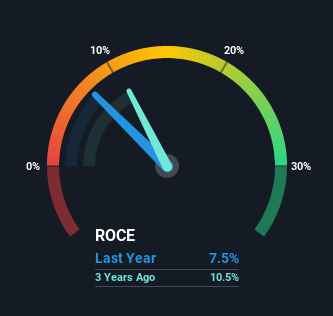- Hong Kong
- /
- Electronic Equipment and Components
- /
- SEHK:8375
Vertical International Holdings (HKG:8375) Will Be Hoping To Turn Its Returns On Capital Around
If we want to find a potential multi-bagger, often there are underlying trends that can provide clues. Firstly, we'll want to see a proven return on capital employed (ROCE) that is increasing, and secondly, an expanding base of capital employed. Ultimately, this demonstrates that it's a business that is reinvesting profits at increasing rates of return. In light of that, when we looked at Vertical International Holdings (HKG:8375) and its ROCE trend, we weren't exactly thrilled.
What is Return On Capital Employed (ROCE)?
Just to clarify if you're unsure, ROCE is a metric for evaluating how much pre-tax income (in percentage terms) a company earns on the capital invested in its business. Analysts use this formula to calculate it for Vertical International Holdings:
Return on Capital Employed = Earnings Before Interest and Tax (EBIT) ÷ (Total Assets - Current Liabilities)
0.075 = HK$8.0m ÷ (HK$155m - HK$48m) (Based on the trailing twelve months to September 2021).
So, Vertical International Holdings has an ROCE of 7.5%. In absolute terms, that's a low return but it's around the Electronic industry average of 7.9%.
See our latest analysis for Vertical International Holdings

Historical performance is a great place to start when researching a stock so above you can see the gauge for Vertical International Holdings' ROCE against it's prior returns. If you want to delve into the historical earnings, revenue and cash flow of Vertical International Holdings, check out these free graphs here.
What Can We Tell From Vertical International Holdings' ROCE Trend?
On the surface, the trend of ROCE at Vertical International Holdings doesn't inspire confidence. Over the last five years, returns on capital have decreased to 7.5% from 44% five years ago. Although, given both revenue and the amount of assets employed in the business have increased, it could suggest the company is investing in growth, and the extra capital has led to a short-term reduction in ROCE. And if the increased capital generates additional returns, the business, and thus shareholders, will benefit in the long run.
On a related note, Vertical International Holdings has decreased its current liabilities to 31% of total assets. So we could link some of this to the decrease in ROCE. Effectively this means their suppliers or short-term creditors are funding less of the business, which reduces some elements of risk. Some would claim this reduces the business' efficiency at generating ROCE since it is now funding more of the operations with its own money.
The Key Takeaway
In summary, despite lower returns in the short term, we're encouraged to see that Vertical International Holdings is reinvesting for growth and has higher sales as a result. But since the stock has dived 72% in the last three years, there could be other drivers that are influencing the business' outlook. Regardless, reinvestment can pay off in the long run, so we think astute investors may want to look further into this stock.
If you'd like to know more about Vertical International Holdings, we've spotted 5 warning signs, and 2 of them are potentially serious.
For those who like to invest in solid companies, check out this free list of companies with solid balance sheets and high returns on equity.
New: Manage All Your Stock Portfolios in One Place
We've created the ultimate portfolio companion for stock investors, and it's free.
• Connect an unlimited number of Portfolios and see your total in one currency
• Be alerted to new Warning Signs or Risks via email or mobile
• Track the Fair Value of your stocks
Have feedback on this article? Concerned about the content? Get in touch with us directly. Alternatively, email editorial-team (at) simplywallst.com.
This article by Simply Wall St is general in nature. We provide commentary based on historical data and analyst forecasts only using an unbiased methodology and our articles are not intended to be financial advice. It does not constitute a recommendation to buy or sell any stock, and does not take account of your objectives, or your financial situation. We aim to bring you long-term focused analysis driven by fundamental data. Note that our analysis may not factor in the latest price-sensitive company announcements or qualitative material. Simply Wall St has no position in any stocks mentioned.
About SEHK:8375
Data Union Capital International Holdings Group
An investment holding company, manufactures and trades aluminum electrolytic capacitors in Hong Kong, the People's Republic of China, Japan, and Macau.
Excellent balance sheet with low risk.
Market Insights
Community Narratives



